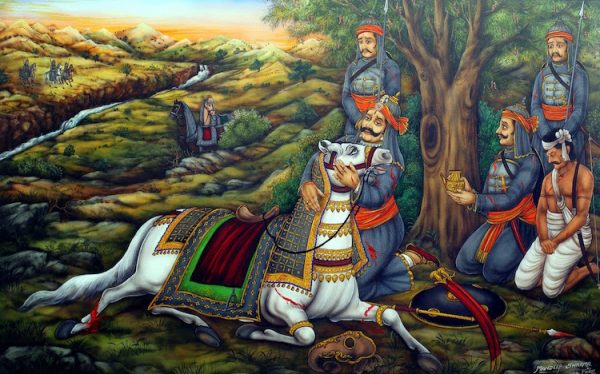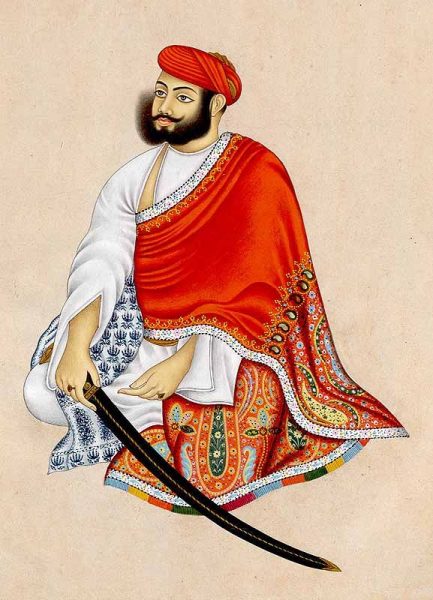The land of Mewar boasts of glorious history, culture and traditions that have survived the test of time. The story of Mewar is a brilliant saga of the survival of ‘Swadharma’ and ‘Swabhiman’ against all kinds of attacks and invasions. The valiant Sisodia Rajputs who trace their ancestry to the Surya Devata or the Sun God have fought against all attacks throughout history and remained one of the very few princely states that constantly resisted the supremacy of the rulers of Delhi during the medieval period.

Source: RajRAS
It is interesting to note, however, that it was not just the Rajput rulers who resisted attacks and fought valiantly. It was a host of other brave men and women who fought and made sacrifices to protect the honour and sovereignty of Mewar state. But for their wholehearted collective efforts, the kings might have fallen short in their sacred duty of defence of Mewar.
From the generosity of Bhamashah who provided Maharana Pratap with the resources of wealth to fight battles and the Afghan chiefs like Hakim Khan Suri who laid down their lives in Haldighati, to the supreme sacrifice of Panna Dhai who gave up her own son for her loyalty towards the sacred land of Mewar.
The histories of Mewar are loaded with stories of pride, loyalty and indomitable courage. One such contribution which has been continuous and enormous, from the beginning to the present day has been that of the Vanputras who have aided the Maharanas in many battles against the Mughals and have resisted independently against the encroachment and oppression of the British.
The land of Mewar is known as ‘Medapat’ in ancient Sanskrit inscriptions and manuscripts due to the presence of a ‘Meda’ community which used to inhabit this region in ancient times.[1] The region of Mewar comprises the present-day districts of Udaipur, Chittorgarh, Pratapgarh, Rajsamand, Bhilwara, Banswara etc. A number of forest communities inhabit the dense foothills of the Aravallis and act as the proud guards of Mewar. The most prominent tribes of Mewar include Bhils (link of Bhil Tribe Article) , Meenas (link of Meena Tribe Article) and Garasias out of which Bhils stand out in terms of their unparalleled contribution and bravery.
Uncanny Facts about the Bhils and the Guhas
Though the early histories of the Bhils and the Rajputs of Mewar are covered in some uncertainties due to the lack of availability of and research on inscriptions and pedigrees, it can be concluded that before the consolidation of the Guhilot dynasty, it was the Bhils who ruled large parts of this region. Col. James Tod, in his extensive classic, ‘Annals and Antiquities of Rajasthan’ traces the origin of Guha or Guhil, the ancestor of the Guhilot dynasty to Valabhi in Gujarat. He tells the story of young Guha growing up amidst the Bhils after his mother Pushpavati committed Jauhar as her husband Sheeladitya, the ruler of Valabhi, died fighting while defending Valabhi against enemies.
The Bhils were impressed by his war-like skills and kept him in their protection as the Bhil chief Mandalika ruled Idar. Guha was declared the next leader of the Bhils when one of the boys cut his finger and applied the tika of sovereignty using his blood on Guha’s forehead. Guha then killed his benefactor to achieve the throne. Tod then draws the story further when he mentions the killing of the Kshatriya king Nagaditya at the hands of the Bhils and the recapture of Idar. The son of Nagaditya, who came to be known as Bappa Rawal was again raised by Bhils and two Bheels: Baldeo from Undri and Dewa from Oguna Panora performed the tika ceremony for Bappa Rawal using their blood.[2]
Mahakavi Shyamaldas who wrote the authentic magnum opus, Veer Vinod and G. S. Ojha who wrote his two-volume book, ‘Udaipur Rajya ka itihaas’, dismiss these claims by Tod as mere concocted stories or folklore which might not have a basis in historical evidence. Ojha argues that these stories of Tod are affected by historical inaccuracies and could have been based on Jain texts whose historicity is uncertain. While Ojha refutes the claim of Valabhi, Veer Vinod agrees with Tod over the argument of Valabhi and argues that the origins of the Guhil dynasty could be traced back to Anandpur in Gujarat, based on a study of inscriptions.[3] Both Veer Vinod and G.S. Ojha agree on the fact that it is possible that Guha had a large kingdom stretching up to Agra as a large number of coins with ‘Sri Guhil’ inscribed on them have been unearthed from Agra.

Source: History Flame
On the basis of this, Ojha concludes that if Guhil was a ruler of such a large territory and had coins issued in his name, then it was quite impossible for him to have started from the humble origins mentioned in the Tod story. Moreover, Tod mistakenly calls Nagaditya the father of Bappa Rawal which goes contrary to historical evidence around the same. Besides this, the uncanny similarities in the two stories of Guha and Bappa Rawal presented by Tod also cast a shadow of a doubt.
That being said, the benefit of the doubt remains that the coins belonged to some other descendant of Guha with the same family name because both Veer Vinod and Ojha admit that the script found on the coins perhaps, did not belong to the time period of Guha. Moreover, this cannot be denied that there indeed was some close relationship between the early Guhilots and the Bhils due to many reasons.
Origin of the Bhil Community
Many branches of the Bhils trace their origins to the Sisodia Rajputs and claim Suryavanshi descent. Some believe that they retired to the forests due to invasions of the mlecchas (People of foreign extraction in ancient India) or the constant infighting with other Kshatriya kings, some say that they attained the status of Bhils because they committed the sin of eating beef and others claim that they were Rajputs who married into the Bhil community. All these beliefs point to an exciting inference, that in the early days, there was a very close relationship of intermingling and interaction between the two communities and community barriers were relatively fluid. We could also infer that intermarriage could have been commonplace. Before the coming of Islam, caste identities and community barriers in Indian society were less rigid and more flexible. Another marker of similarity is the belief in faith and worship between the two.
The house of Mewar is believed to be ruled by Eklingji, a variant of Shiva and the Maharana is said to be ruling on the behalf of the deity as his Diwan. The Bhils too have origin myths associated with Shiva and till today strongly believe in a Shaiva tradition. The story presented by Tod could have been historically inaccurate but it may not be absolutely deprived of truth. This is clear through the tradition which is so revered in the House of Mewar in which the successor to the Maharana of Mewar does not assume the title of Maharana unless a Bhil chieftain puts a tilak on his head with his own blood.[4] In this respect, the story of either Guha or Bappa Rawal’s childhood presented by Tod assumes some legitimacy.
Click here to know more about the Bhil Community.
[2] 1 Col. James Tod, Annals and Antiquities of Rajasthan 180-181 (Rupa Publications India 1997)
[3] 1 Mahakavi Shyamaldas, Veer Vinod248 (Maharana Mewar Historical Publication Trust Udaipur 2017)
[4]Eternal Mewar, http://www.eternalmewar.in/ (last visited Jan 23, 2021)


